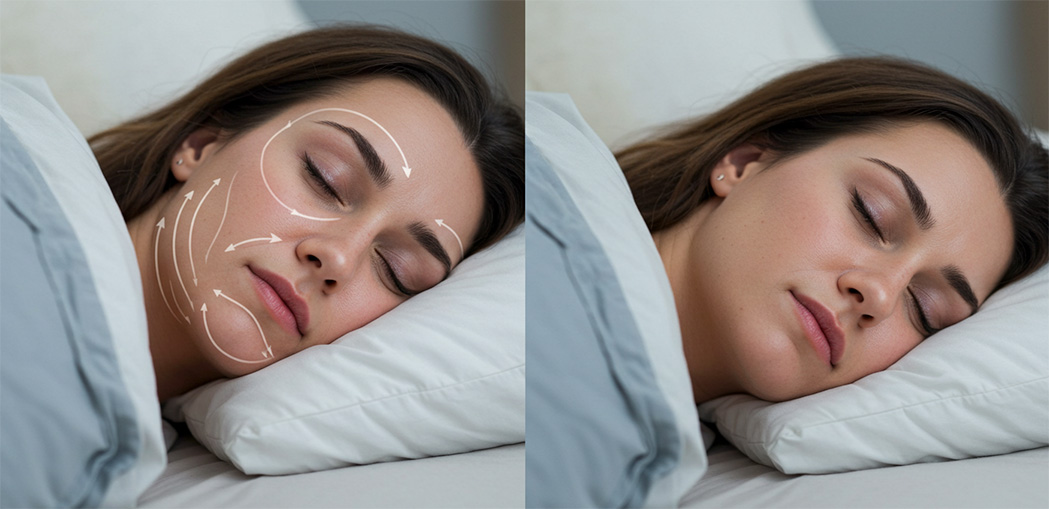We've all heard about the importance of beauty sleep, but what if the way you're catching those precious Z's is actually working against your skincare goals? If you're a dedicated side sleeper, you might want to pay attention to what dermatologists and plastic surgeons are saying about the connection between sleep position and facial symmetry.
The Science Behind Sleep Lines
Here's the not-so-beautiful truth: when we sleep on our side, we create constant pressure on specific areas of the face, particularly around the nasolabial folds—those lines that run from your nose to the corners of your mouth. Think of it like this: imagine pressing a piece of fabric against a surface for eight hours every night. Over time, that fabric is going to develop some permanent creases.
The pressure from side sleeping can create what experts call a "flattening effect" on one side of the face, potentially depleting collagen and elastin unevenly and creating more fine lines and wrinkles on your preferred sleep side. It's like giving yourself a very slow, very gentle facial massage—except instead of plumping your skin, you're gradually pressing it into submission.
More Than Just Wrinkles
But it's not just about sleep lines. The mechanical forces of compression and traction that occur during side sleeping can result in what dermatologists call "sleep wrinkles," and these repetitive forces can become permanent over time. Even more concerning? Recent research has found that people with a consistent sleep side preference show "a significant increase in ipsilateral upper eyelid asymmetry and an inferior upper eyelid position on the sleep side"—translation: your eyelids might actually start to droop more on the side you sleep on.
The Great Debate: Is It Really That Simple?
Before you panic about your beloved side-sleeping habit, let's get real about what the experts are saying. Some medical professionals argue that the connection isn't as straightforward as it seems, pointing out that "we may all start off on our side but we toss and turn in the night, so our position changes multiple times".
The reality is that facial asymmetry is incredibly common—studies show that 12-37% of people have some degree of it, with some research suggesting the number could be even higher. Most of this comes down to genetics, not your pillow preference.
The Back-Sleeping Beauty Standard
So what's a beauty-conscious sleeper to do? The gold standard recommendation from skincare experts is sleeping on your back, as this position helps distribute weight evenly across the entire face, avoiding excessive pressure on specific areas. It's the sleeping position of choice for many models and actresses who want to maintain their looks—and now you know why.
Real Talk: Making the Switch
Let's be honest—changing your sleep position isn't exactly as simple as switching foundations. If you've been a side sleeper your whole life, suddenly sleeping on your back can feel like trying to sleep standing up. But don't worry, there are ways to ease into it:
Start Small: Try beginning the night on your back, even if you naturally roll over later.
Pillow Strategy: Use strategically placed pillows or support cushions to give additional support to your head and neck, helping you maintain the face-up position throughout the night.
The Compromise: If back sleeping just isn't happening, try alternating which side you sleep on each night. Think of it as giving each side of your face equal time to recover.
Beyond the Pillow: The Bigger Picture
While your sleep position might play a role in facial aging, it's important to remember that it's just one piece of the puzzle. Other lifestyle factors can affect facial symmetry too, including sun exposure (hello, driver's side aging!), smoking habits, repeated facial expressions, and the natural aging process.
The good news? Even if sleep position has contributed to some asymmetry, it's rarely the sole cause, and there are both non-surgical and surgical options available to help address concerns.
The Bottom Line on Beauty Sleep
While the jury's still out on exactly how much your sleep position affects your face, one thing is clear: being mindful of how you sleep and making small adjustments to your routine can help protect your skin and maintain a more youthful appearance over time.
So tonight, when you're settling in for your beauty sleep, consider giving back sleeping a try. Your future self (and your skincare routine) might just thank you. And remember—perfection isn't the goal here. Even the most symmetrical faces have their unique characteristics that make them beautiful. Sometimes the best beauty secret is simply embracing what makes you, you.
*Sweet (and symmetrical) dreams!*
